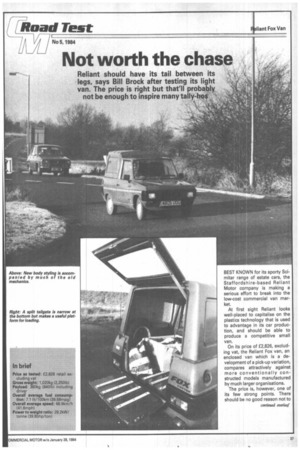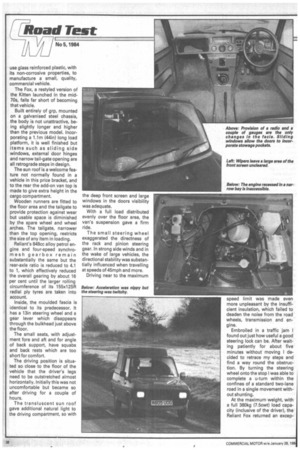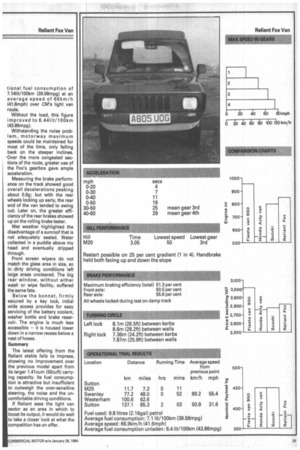Reliant should have its tail between its legs, says Bill
Page 41

Page 42

Page 43

If you've noticed an error in this article please click here to report it so we can fix it.
Brock after testing its light van. The price is right but that'll probably not be enough to inspire many tally-hos
BEST KNOWN for its sporty Scimitar range of estate cars, the Staffordshire-based Reliant Motor company is making a serious effort to break into the low-cost commercial van market.
At first sight Reliant looks well-placed to capitalise on the plastics technology that is used to advantage in its car production, and should be able to produce a competitive small van.
On its price of £2,826, excluding vat, the Reliant Fox van, an enclosed van which is a development of a pick-up variation, compares attractively against more conventionally constructed models manufactured by much larger organisations.
The price is, however, one of its few strong points. There should be no good reason not to use glass reinforced plastic, with its non-corrosive properties, to manufacture a small, quality, commercial vehicle.
The Fox, a restyled version of the Kitten launched in the mid70s, falls far short of becoming that vehicle.
Built entirely of grp, mounted on a galvanised steel chassis, the body is not unattractive, being slightly longer and higher than the previous model. Incorporating a 1.1m (44in) long load platform, it is well finished but items such as sliding side windows, external door hinges and narrow tail-gate opening are all retrograde steps in design.
The sun roof is a welcome feature not normally found in a vehicle in this price bracket, and to the rear the add-on van top is made to give extra height in the cargo compartment.
Wooden runners are fitted to the floor area and the tailgate to provide protection against wear but usable space is diminished by the spare wheel and wheel arches. The tailgate, narrower than the top opening, restricts the size of any item in loading.
Reliant's 848cc alloy petrol engine and four-speed synchromesh gearbox remain substantially the same but the rear-axle ratio is reduced to 4.1 to 1, which effectively reduced the overall gearing by about 16 per cent until the larger rolling circumference of its 155x12SR radial ply tyres are taken into account.
Inside, the moulded fascia is identical to its predecessor. It has a 13in steering wheel and a gear lever which disappears through the bulkhead just above the floor.
The small seats, with adjustment fore and aft and for angle of back support, have squabs and back rests which are too short for comfort.
The driving position is situated so close to the floor of the vehicle that the driver's legs need to be outstretched almost horizontally. Initially this was not uncomfortable but became so after driving for a couple of hours.
The transluscent sun roof gave additional natural light to the driving compartment, so with the deep front screen and large windows in the doors visibility was adequate.
With a full load distributed evenly over the floor area, the van's suspension gave a firm ride.
The small steering wheel exaggerated the directness of the rack and pinion steering gear. In strong side winds and in the wake of large vehicles, the directional stability was substantially influenced when travelling at speeds of 45mph and more.
Driving near to the maximum speed limit was made even more unpleasant by the insufficient insulation, which failed to deaden the noise from the road wheels, transmission and engine.
Embroiled in a traffic jam I found out just how useful a good steering lock can be. After waiting patiently for about five minutes without moving I decided to retrace my steps and find a way round the obstruction. By turning the steering wheel onto the stop I was able to complete a u-turn within the confines of a standard two-lane road in a single movement without shunting.
At the maximum weight, with a full 380kg (7.5cwt) load capacity (inclusive of the driver), the Reliant Fox returned an excep
tional fuel consumption of 7.141it/100km (39.58mpg) at an average speed of 6 6km/h (41.6mph) over CM's light van route.
Without the load, this figure Improved to 6.441it/1 00km (43.86mpg).
Withstanding the noise probI m, motorway maximum speeds could be maintained for most of the time, only falling back on the steeper inclines. Over the more congested sections of the route, greater use of the Fox's gearbox gave ample acceleration.
Measuring the brake performance on the track showed good overall decelerations peaking about 0.9g; but with the rear wheels locking up early, the rear end of the van tended to swing out. Later on, the greater efficiency of the rear brakes showed up on the rolling brake tester.
Wet weather highlighted the disadvantage of a sunroof that is not adequately sealed. Water collected in a puddle above my head and eventually dripped through.
Front screen wipers do not match the glass area in size, so in dirty driving conditions left large areas uncleared. The big rear window, without either wash or wipe facility, suffered the same fate.
Below the bonnet, firmly secured by a key lock, initial wide access provides for easy servicing of the battery coolant, washer bottle and brake reservoir. The engine is much less accessible it is housed lower down in a narrow recess below a nest of hoses.
Summary The latest offering from the Reliant stable fails to impress, showing no improvement over the previous model apart from its larger 1.41cum (50cuft) carrying capacity. Its fuel consumption is attractive but insufficient to outweigh the over-sensitive steering, the noise and the uncomfortable driving conditions.
If Reliant sees the light van sector as an area in which to boost its output, it would do well to take a closer look at what the competition has on offer.










































































